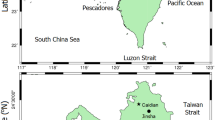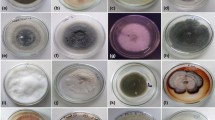Abstract
Endophytic fungi are major contributors to fungal diversity and an important component of plant microbiota. Plants growing in biodiversity hotspots and having ethnobotanical utility are often explored for the presence of endophytic fungi with bioactive potential. Western Ghat mountains of India are one of the ten famous biodiversity hotspots in the world. Hence, in the present study, we investigated the diversity of endophytic fungi associated with tissues of Nothapodytes foetida (a tree), Hypericum mysorense (a shrub) and Hypericum japonicum (a herb) collected from forests of Western Ghats with emphasis on diversity of endophytic fungi harbored in different tissues of three plants and their antimicrobial and free radical scavenging activities. A total of 298 isolates belonging to 31 genera were isolated along with dark septate and sterile fungi. All isolates belonged to Dothidiomycetes, Eurotiomycetes and Sordariomycetes of the phylum Ascomycota. Most frequent colonizers were Penicillium, Aspergillus, Fusarium, Gliocladium, Cladosporium, Trichoderma, Colletotrichum, and Pestalotiopsis. Endophytes showed neither any host preference nor any dominance of a single species. Ethyl acetate extracts of 39 endophytic fungi exhibited antimicrobial activity against one or more pathogens, of which the activity of Bionectria ochroleuca NOTL33, Chaetomium globosum HYML55, Alternaria brassicae HYMS01, Aspergillus sp. HYML56 was prominent against most of the pathogens tested. 1,1-Diphenyl-2-picrylhydrazyl (DPPH) and 2,2′-azinobis-3-ethylbenzothiazoline-6-sulfonic acid (ABTS) free radicals were effectively quenched by the ethyl acetate extracts of 28 isolates and 34 isolates, respectively. This study is the first of its kind in H. mysorense and H. japonicum, and not only describes the endophytic diversity of these plants but also emphasizes the bioactive potential of endophytic isolates for future use in agricultural, pharmaceutical and industrial applications.




Similar content being viewed by others
References
Amna T, Puri SC, Verma V, Sharma JP, Khajuria RK, Musarrat J, Spiteller M, Qazi GN (2006) Bioreactor studies on the endophytic fungus Entrophospora infrequens for the production of an anticancer alkaloid camptothecin. Can J Microbiol 52:189–196
Bauer AW, Kirby WM, Sherris JC, Turck M (1966) Antibiotic susceptibility testing by a standardized single disk method. Am J Clin Pathol 45:493–496
Caruso T, Pigino G, Bernini F, Bargagli R, Migliorini M (2008) The Berger–Parker index as an effective tool for monitoring the biodiversity of disturbed soils: a case study on Mediterranean oribatid (Acari: oribatida) assemblages. In: Hawksworth DL, Bull AT (eds) Biodiversity and conservation in Europe. Springer, Dordrecht, pp 35–43
Dai J, Krohn K, Flörke U, Draeger S, Schulz B, Kiss-Szikszai A, Antus S, Kurtán T, van Ree T (2006) Metabolites from the endophytic fungus Nodulisporium sp. from Juniperus cedre. Eur J Org Chem 2006:3498–3506
Dhargalkar S, Bhat DJ (2009) Echinosphaeria pteridis sp. nov. and its Vermiculariopsiella anamorph. Mycotaxon 108:115–122
Ellis MB (1971) Dematiaceous hyphomycetes. Commonwealth Mycological Institute, Kew
Ellis MB (1976) More dematiaceous hyphomycetes. Commonwealth Mycological Institute, Kew
Fisher RA, Corbet AS, Williams CB (1943) The relation between the number of species and the number of individuals in a random sample of an animal population. J Anim Ecol 12:42–58
Foyer CH, Shigeoka S (2011) Understanding oxidative stress and antioxidant functions to enhance photosynthesis. Plant Physiol 155:93–100
Fulzele DP, Satdive RK (2005) Distribution of anticancer drug camptothecin in Nothapodytes foetida. Fitoterapia 76:643–648
Gao JM, Xiao J, Zhang Q, Tang JJ, Zhang AL, Gao YQ (2014) Secondary metabolites from the endophytic Botryosphaeria dothidea of Melia azedarach, and their antifungal, antibacterial, antioxidant, and cytotoxic activities. J Agric Food Chem 62:3584–3590. doi:10.1021/jf500054f
Gautam AK (2014) Diversity of fungal endophytes in some medicinal plants of Himachal Pradesh. India Arch Phytopathol Plant Protect 47:537–544
Gilman JC (1971) A manual of soil fungi. Iowa State University Press, Iowa
Hamilton CE, Bauerle TL (2012) A new currency for mutualism? Fungal endophytes alter antioxidant activity in hosts responding to drought. Fungal Divers 54:39–49
Harper Ø, Harper DAT, Ryan PD (2001) PAST: paleontological statistics software package for education and data analysis. Palaeontol Electron 4:9
Hoffman MT, Arnold AE (2008) Geographic locality and host identity shape fungal endophyte communities in cupressaceous trees. Mycol Res 112:331–344
Huang WY, Cai YZ, Hyde KD, Corke H, Sun M (2008) Biodiversity of endophytic fungi associated with 29 traditional Chinese medicinal plants. Fungal Divers 33:61–75
Hyde KD, Soytong K (2008) The fungal endophyte dialemma. Fungal Divers 33:163–173
Jin H, Yan Z, Liu Q, Yang X, Chen J, Qin B (2013) Diversity and dynamics of fungal endophytes in leaves, stems and roots of Stellera chamaejasme L. in northwestern China. Antonie Van Leeuwenhoek 104:949–963
Jost L (2006) Entropy and diversity. Oikos 113:363–375
Kumar DSS, Hyde KD (2004) Biodiversity and tissue-recurrence of endophytic fungi in Tripterygium wilfordii. Fungal Divers 17:69–90
Kurose D, Furuya N, Tsuchiya K, Tsushima S, Evans HC (2012) Endophytic fungi associated with Fallopia japonica (Polygonaceae) in Japan and their interactions with Puccinia polygoni-amphibii var. tovariae, a candidate for classical biological control. Fungal Biol 116:785–791
Larsen AG, Knøchel S (1997) Antimicrobial activity of food-related Penicillium sp. against pathogenic bacteria in laboratory media and a cheese model system. J Appl Microbiol 83:111–119
Mandyam K, Jumpponen A (2014) Unraveling the dark septate endophyte functions: insights from the Arabidopsis model. In: Verma VC, Gange AC (eds) Advances in endophytic research. Springer, Bangalore, pp 115–141
Moorthi S, Krishnakumari S, Thomas RA (2010) Hypericum mysorense: a potential antioxidant and antidepressant folk medicinal plant of Nilgiris Biosphere-Western Ghats. Res J Biotechnol 5:68–73
Musavi SF, Balakrishnan RM (2013) Biodiversity, antimicrobial potential, and phylogenetic placement of an endophytic Fusarium oxysporum NFX 06 isolated from Nothapodytes foetida. J Mycol. doi:10.1155/2013/172056
Nath A, Chattopadhyay A, Joshi SR (2013) Biological activity of endophytic fungi of Rauwolfia serpentina Benth: an ethnomedicinal plant used in folk medicines in Northeast India. Proc Natl Acad Sci India Sect B Biol Sci. doi:10.1007/s40011-013-0184-8
Qadri M, Rajput R, Abdin MZ, Vishwakarma RA, Riyaz-Ul-Hassan S (2014) Diversity, molecular phylogeny, and bioactive potential of fungal endophytes associated with the Himalayan blue pine (Pinus wallichiana). Microb Ecol 67:877–887. doi:10.1007/s00248-014-0379-4
Rhoden SA, Garcia A, Rubin Filho CJ, Azevedo JL, Pamphile JA (2012) Phylogenetic diversity of endophytic leaf fungus isolates from the medicinal tree Trichilia elegans (Meliaceae). Genet Mol Res 11:2513–2522
Rodriguez RJ, White JE Jr, Arnold AE, Redman RS (2009) Fungal endophytes: diversity and functional roles. New Phytol 182(2):314–330. doi:10.1111/j.1469-8137.2009.02773.x
Samaga PV, Rai VR (2013a) Evaluation of pharmacological properties and phenolic profile of Hypericum japonicum Thunb. from Western Ghats of India. J Pharm Res 7:626–632. doi:10.1016/j.jopr.2013.07.029
Samaga PV, Rai VR (2013b) Free radical scavenging activity and active metabolite profiling of endophytic fungi from Nothapodytes foetida and Hypericum mysorense. Int J Chem Anal Sci 4:96–101. doi:10.1016/j.ijcas.2013.07.007
Samaga PV, Rai VR, Rai KML (2014a) Bionectria ochroleuca NOTL33—an endophytic fungus from Nothapodytes foetida producing antimicrobial and free radical scavenging metabolites. Ann Microbiol 64:275–285. doi:10.1007/s13213-013-0661-6
Samaga PV, Rai VR, Rai KML (2014b) Production of an antimicrobial cytochalasan by an endophytic Chaetomium globosum HYML55 from Hypericum mysorense and its RNA secondary structure analysis. Chem Ecol 30:566–578
Shannon CE, Weaver W (1949) The mathematical theory of communication. University of Illinois Press, Urbana
Shen M, Liu L, Li DW, Zhou WN, Zhou ZP, Zhang CF, Luo YY, Wang HB, Li HY (2013) The effect of endophytic Peyronellaea from heavy metal-contaminated and uncontaminated sites on maize growth, heavy metal absorption and accumulation. Fungal Ecol 6:539–545
Simpson EH (1949) Measurement of species diversity. Nature (London) 163:688
Srinivas K, Das B (2003) 9-Methoxy-20-O-acetylcamptothecin, a minor new alkaloid from Nothapodytes foetida. Biochem Syst Ecol 31:85–87
Strobel GA (2014) Methods of discovery and techniques to study endophytic fungi producing fuel-related hydrocarbons. Nat Prod Rep 31:259–272. doi:10.1039/C3NP70129H
Strobel GA, Knighton B, Kluck K, Ren Y, Livinghouse T, Griffin M, Spakowicz D, Sears J (2008) The production of myco-diesel hydrocarbons and their derivatives by the endophytic fungus Gliocladium roseum (NRRL 50072). Microbiology 154:3319–3328
Sultan S, Sun L, Blunt JW, Cole AL, Munro MH, Ramasamy K, Weber JFF (2014) Evolving trends in the dereplication of natural product extracts. 3: further lasiodiplodins from Lasiodiplodia theobromae an endophyte from Mapania kurzii. Tetrahedron Lett 55:453–455
Takemoto S, Masuya H, Tabata M (2014) Endophytic fungal communities in the bark of canker-diseased Toxicodendron vernicifluum. Fungal Ecol 7:1–8. doi:10.1016/j.funeco.2013.10.004
Tamura K, Peterson D, Peterson N, Stecher G, Nei M, Kumar S (2011) MEGA5: molecular evolutionary genetics analysis using maximum likelihood, evolutionary distance, and maximum parsimony methods. Mol Biol Evol 28:2731–2739
U’Ren JM, Lutzoni F, Miadlikowska J, Laetsch AD, Arnold AE (2012) Host and geographic structure of endophytic and endolichenic fungi at a continental scale. Am J Bot 99:898–914
Verma SK, Gond SK, Mishra A, Sharma VK, Kumar J, Singh DK, Kumar A, Goutam J, Kharwar RN (2013) Impact of environmental variables on the isolation, diversity and antibacterial activity of endophytic fungal communities from Madhuca indica Gmel. at different locations in India. Ann Microbiol 2:721–734
White TJ, Bruns TD, Lee S, Taylor JW (1990) Amplification and direct sequencing of fungal ribosomal RNA genes for phylogenetics. In: Innis MA, Gelfand DH, Shinsky JJ, White TJ (eds) PCR protocols: a guide to methods and applications. Academic, New York, pp 315–322
Yang L, Li WJ, Long J, Yang AM, Yang ZD, Liu XF, Hua D, Wang WJ, Ma JH (2014) Isolation of endophytic fungi from Ephedra intermedia and research antibacterial activity of secondary metabolite produced by the fungi. Adv Mater Res 881:488–492
Zhao J, Zhou L, Wang J, Shan T, Zhong L, Liu X, Gao X (2010) Endophytic fungi for producing bioactive compounds originally from their host plants. Curr Res Technol Educ Trop Appl Microbiol Microb Biotechnol 1:567–576
Zheng JH, Kang JC, Lei BX, Li QR, Wen TC, Meng ZB (2013) Diversity of endophytic fungi associated with Ginkgo biloba. Mycosystema 32:671–681
Zuo GY, An J, Han J, Zhang YL, Wang GC, Hao XY, Bian ZQ (2012) Isojacareubin from the Chinese Herb Hypericum japonicum: potent antibacterial and synergistic effects on clinical methicillin-resistant Staphylococcus aureus (MRSA). Int J Mol Sci 13:8210–8218
Acknowledgments
This study was supported by a grant from the Indian Council of Medical Research (ICMR), Government of India in the form of senior research fellowship (grant no. 45/70/BMS/TRM/2011). The authors also acknowledge the help of Dr. D.J. Bhat, Professor, Goa University for help with the identification of the fungi.
Conflict of interest
The authors have no any conflict of interest.
Author information
Authors and Affiliations
Corresponding author
Rights and permissions
About this article
Cite this article
Samaga, P.V., Rai, V.R. Diversity and bioactive potential of endophytic fungi from Nothapodytes foetida, Hypericum mysorense and Hypericum japonicum collected from Western Ghats of India. Ann Microbiol 66, 229–244 (2016). https://doi.org/10.1007/s13213-015-1099-9
Received:
Accepted:
Published:
Issue Date:
DOI: https://doi.org/10.1007/s13213-015-1099-9




